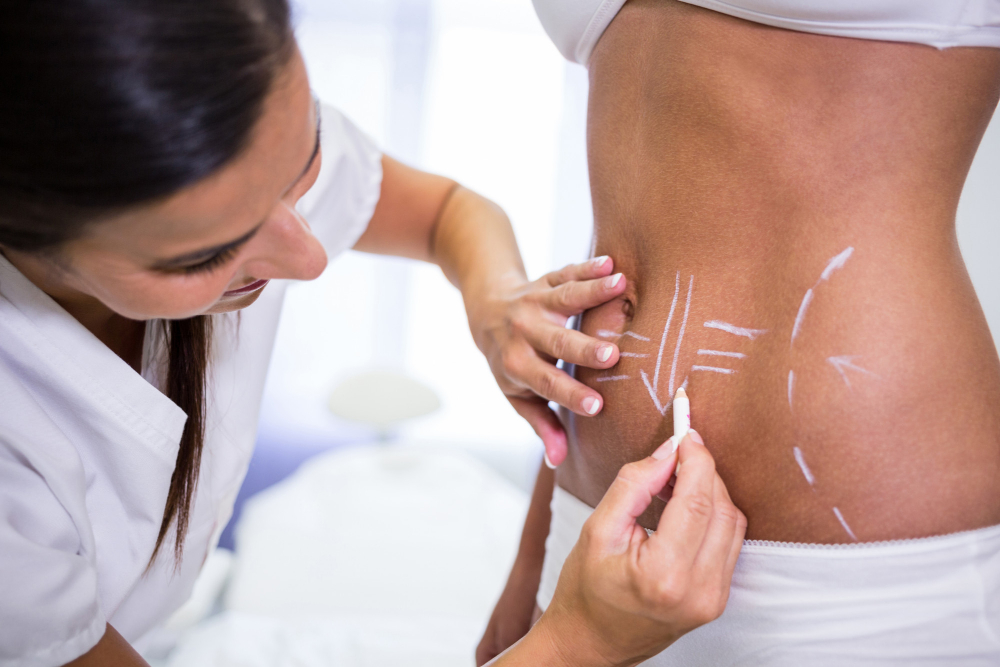The plastic surgeon at any Clinic in Dubai removes the excess skin and/or fat during the tummy tuck procedure, which will give you a tighter stomach. This operation gives a nice and lasting result. You can opt for a mini tummy tuck or a full tummy tuck, in combination with liposuction if necessary. During your conversation with the plastic surgeon in Dubai, various options will be discussed.
A tummy tuck will flatten your stomach, but you shouldn’t expect perfection. You should not see a surgical correction of a large or flabby stomach as an opportunity to lose extra weight. In addition, the operation will leave scars; a small scar around the navel and a long scar on the underside of the abdomen. The scars will always be visible but will fade over time. You should also be aware that the skin area under the navel will become temporarily numb and sometimes it will remain very few complaints.
How exactly Tummy Tuck Procedure is Done?
During the operation, the plastic surgeon completely loosens the abdominal wall from the underlying muscle layer, up to the rib cage and the sternum. The belly button is detached from the skin all around but remains attached to the abdominal muscles in the depth so that it stays in place. Then the skin is pulled taut and the excess skin and fat tissue removed. If necessary, there will also be additional liposuction(suction of adipose tissue) can be performed. When your abdominal muscles are stretched, in some cases they are immediately firmed. To let the navel come out again, a hole is made in the taut skin of the abdomen. The navel is then stitched into it. A number of drains (thin tubes) are left behind so that the wound fluid can escape. These are usually removed the next day.

Preparing for surgery
Are you taking blood-thinning drugs? Please report this during your first meeting with the plastic surgeon.
In addition, it is wise to stop smoking completely at least six weeks in advance, because smoking constricts the blood vessels, which can cause problems in wound healing.
If you are overweight, it is wise to lose weight before the operation, possibly with the help of a general practitioner or dietician. Being overweight increases the risk of complications. That is why the plastic surgeon will not (yet) perform the procedure for overweight people because of the increased risks. A tummy tuck is performed under general anesthesia (anesthesia). You will stay in the hospital for 1 to 2 nights.
After the operation
A tummy tuck is not very painful, but the abdomen can feel tense. To avoid tension on the wound, you will be nursed temporarily in a semi-sitting position after the operation. Coughing, sneezing, straining, but also laughing is extra annoying. If desired, you can use paracetamol for the pain. If you experience abnormal pain, swelling or fever, please contact us.
If your abdominal muscles are also strengthened during the abdominoplasty, you will continue to suffer from the abdominal wall for longer and you should be careful with too much tension of the abdominal muscles. If an abdominal muscle correction was not necessary, you can use the abdominal muscles a little faster and get out of bed after the procedure. In the beginning you should then walk slightly bent over; gradually you can move more upright. You will return to us for a wound checkup one week after the operation.
You are not allowed to drive yourself after the procedure. Make sure someone is there to take you home. To support the abdominal wall during healing, you may need to wear a supportive corset around the abdomen or panties for a few weeks. The abdominal wall needs these weeks to heal. You are not yet allowed to perform heavy physical work and it is best to rest. After about two weeks you can resume your daily activities. Only after six weeks you can do heavier work and exercise again. The scars from a tummy tuck run around the navel and mostly within the ‘bikini line’. The scars should not be uncovered in the sun or under the tanning bed for the first six months after the operation.
What is gynecomastia surgery? Dubai Plastic Surgery
Tummy Tuck Surgery Risks
A tummy tuck has the same risks as any other surgery. An infection or impaired slow wound healing may occur. There is also a risk of thrombosis (blocked veins by blood clots). These problems are most likely in people who have too much subcutaneous fat tissue. It is therefore important to have as normal a weight as possible before surgery.
Occasionally, bleeding may occur. You will then have to undergo another operation in which the doctor will close the bleeding blood vessel. Sometimes it is possible that moisture still builds up under the skin, even though the wound drains have been removed. This fluid is removed on an outpatient basis by means of a puncture.
Another complication could be that there is some excess skin around the hips. This is called ‘dog ears’. Usually, this will fade over time. Sometimes it is necessary to remove these ‘dog ears’. This can be done on an outpatient basis under local anesthesia.
What does a tummy tuck cost?

The average initial price of a tummy tuck in Dubai is AED 25,000 to AED 35,000, usually depend on the procedure you are going to take. During the consultation, the doctor will discuss the various treatment options with you and determine what suits you best. On the basis of this, you will receive an explanation of the associated costs. Whatever you choose, you are assured of the very best care at Clinic in Dubai.
- Mini abdominoplasty (excl. Overnight stay)
- Removing the excess skin (below the navel)
- Tummy tuck (excl. Overnight stay): Removing the excess skin and relocating the navel
- Extensive abdominoplasty (excluding overnight stay): Removing the excess skin and correcting the (length) abdominal muscles
- Belly correction: an additional procedure in the case of, for example, an umbilical hernia or retracted navel
11 Best Cosmetic and Plastic Surgeons in Dubai
Tummy Tuck Cost at MedCare Hospital Dubai?
MedCare has Plastic Surgery Centre of Excellence one of the most technologically advanced hospital in Dubai, you can expect the minimum prices starting from AED 30,000 for different tummy tuck procedures.
Tummy Tuck Cost at Lutetia Paris Dubai?
You will discuss your surgical choices with your board-certified specialist plastic surgeon at Lutétia Clinic., you can expect the minimum prices starting from AED 20,000 to AED 35,000 for different tummy tuck procedures.
Tummy Tuck Cost at Dermalase?
Doctor Paolo Iannitelli Specialist Plastic Surgeon at Dermalase Clinic Dubai, you can expect the minimum prices starting from AED 25,000 to AED 35,000 for different tummy tuck procedures.

Frequently Asked Questions
I am overweight, can I still undergo a tummy tuck?
A tummy tuck can give you a significantly flatter stomach, but this procedure is not a solution for obesity. If you are overweight, it is wise to lose weight before the operation. If you are overweight, you run a higher risk of complications such as infection and bleeding. A tummy tuck will give the best results if you are at your target weight before the operation. The Body Mass Index may also never exceed 30.
Unfortunately, we do not perform this operation in our clinic, you can go to the hospital for this.
What is the difference between a tummy tuck and a mini tummy tuck?
You qualify for a mini tummy tuck if the excess skin is below the navel. Excess skin is then removed directly below the navel to just above the pubic bone. If the abdominal wall has relaxed completely, including the skin above the navel, then a total abdominal wall correction is the best solution. The navel will also be reattached during this last procedure. A full abdominoplasty is a much more difficult procedure than a mini-abdominoplasty.
What is the difference between a tummy tuck and liposuction?
With a tummy tuck, you remove both the superficial fat and the excess skin. With liposuction, you remove the excess fat that is between the abdominal muscles and the skin. When there is too much skin (for example due to significant weight loss), liposuction is not sufficient.
Will a tummy tuck be reimbursed?
A tummy tuck is generally not reimbursed by the health insurer. You usually have to pay for the operation yourself. However, there are cases where reimbursement is possible. However, the rules for this are strict. More information about these rules can be found here, or ask your health insurer.
How long will the recovery take?
It takes about 2 weeks to heal the wound. Between 4 and 6 weeks you can slowly build up again with your daily activities and after about 6 weeks you can start exercising again.






